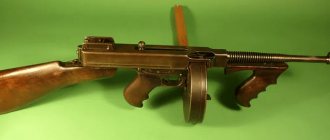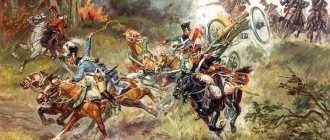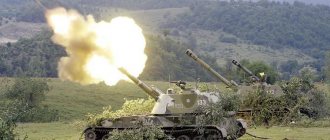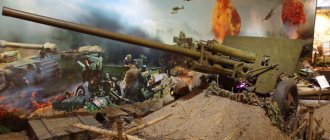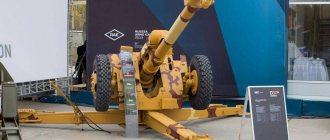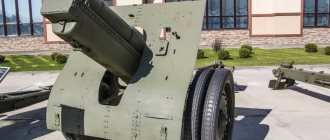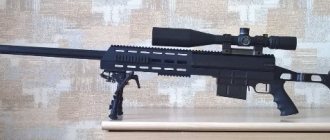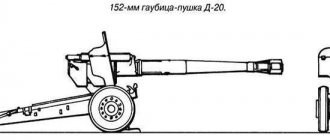"God of War" of the French Army
French artillery was rightfully considered the strongest after the First World War. And after the war, the French military also remembered that stopping development is fraught with consequences.
But the military does not always decide everything even when it comes to the development of the armed forces, especially in peacetime. Politicians decide. So they decided.
Let's take a quick look at what artillery pieces were in service with the French army at the beginning of World War II.
Light field artillery was represented overwhelmingly by Canon de 75 mm mod è le 1897 . One of the first rapid-fire guns, and the first of large-scale ones. Because our cannon, designed by Baranovsky, can be considered the very first, but it never became the main one for our army.
In 1940, the French army had 5,667 guns. Attempts to replace it with a more advanced gun after the First World War came to nothing. And although a wonderful field gun was created under the 1928 program, it did not enter service with the French army, and was only supplied for export. She showed herself very well in the Japanese army. Gun arr. They tried to modernize the 1897, but all modernization came down to a new wheel drive with suspension and wheels on pneumatic tires. Such Canon de 75 mm mod è le 1897 modifié 1938 could already be towed by tractors instead of horses.
However, about seven hundred guns were modernized in this way, since the French preferred to solve the issue by a different method. They developed rolling carts for light artillery: the gun was rolled onto the cart and then easily towed by a tractor at a speed of 20-25 km/h instead of the previous 7-8 km/h. The method is much cheaper. By the way, in the USSR, where there were many old guns, such a cart was also developed at the Grabin Design Bureau. F-29 trolley - intended for a 76-mm gun mod. 1902, and the F-29-II cart for a 107 mm cannon and a 152 mm howitzer. But in the USSR, rolling carts were never produced, but in France they were actively used.
Another method of transporting field guns, which was considered extremely promising in France in the 1920s, was transporting these guns in the back of trucks. And special artillery transporters were developed for this. However, by the end of the 30s this method was no longer used so often.
Another modernization of the 1897 cannon involved the creation of a special round tray on which the cannon was mounted. At the same time, the wheels were raised, and the gun received a 360° firing sector. Such guns were used in anti-tank batteries. However, there were very few batteries and guns with a pallet. On May 10, 1940, there were 10 mixed batteries, containing 47 mm and 75 mm guns.
At the end of the 20s, a new field gun, the Canon de 75 mm mod è le 1897 modifié 33, . And although the name suggested that this was just one of the modifications of the gun mod. 1897, it was a completely new weapon of an original design, popular in those years. The swinging part was indeed almost entirely taken from the 1897 cannon,
Development
Most French artillerymen served in the field artillery, but there were also foot artillery, heavy artillery, horse artillery, mountain artillery, fortress artillery, coastal artillery and colonial artillery. By the end of the war, anti-aircraft artillery and tank units (known as special purpose artillery) also appeared. The latter will be discussed in the next section.
Mobile French anti-aircraft gun during the Battle of the Somme
The last failure
On June 4, after a fairly powerful half-hour artillery barrage, the French and Scots began to advance.
But things didn't work out from the very beginning. Thanks to good fortifications, the Germans did not suffer significant losses. In addition, oddly enough, no one thought of sending sappers to make passages in the minefields, although de Gaulle’s tankers had already encountered them. And most importantly, the tanks advanced again along the obvious route between the forests. As a result, the tanks began to suffer losses from mines, while at the same time they began to be shot at by heavy artillery. In turn, mortars and machine gun fire forced the infantry to lie down. The B1s that went forward encountered the same 88-mm anti-aircraft guns in the depths of the defense and were almost completely destroyed - only three tanks returned.
French Char B1-bis tank knocked out near Abbeville (photo source)
Some soldiers from the infantry lying under fire, unable to bear it, began to retreat back without orders. Colonel Favatier ordered the R35 tanks supporting the attack to fire at them, thanks to which the retreat was stopped. But the attack soon ended with the death of Favatier himself from German artillery fire.
The last attempt to crush the bridgehead failed.
The British also achieved little. The only success was the clearing of small forests by Gordon's 1st Highlander Battalion.
In total, the 2nd DCR lost 40 tanks during the day, the 15th Alpine Regiment supporting it lost 250 people, including the commander, and the 152nd Brigade of the 51st Highlander Division, advancing from the British, lost 563 people. The Germans escaped with forty killed and an unknown number of wounded. It can be assumed that it is unlikely that their losses were more than 200 people.
40 mm Bofors L60. Sweden
It is quite difficult to write about this weapon for two reasons. Firstly, this gun fought in all armies, on both sides of the front. Secondly, the authors’ personal love for this particular gun. Indeed, one of the greatest successes of the designers of that time was the 40-mm cannon of the Swedish concern Bofors.
The gun was ordered to the concern by the Swedish government in 1928 after testing Pom-Pom guns purchased from the British Vickers. The Vickers guns turned out to be quite finicky and underpowered. And the firing range did not suit the Swedes.
The first version of the Bofors L-60, presented by the concern in 1929, also did not impress with its characteristics. The problem was the bolt mechanism. Too heavy and unable to maintain a high rate of fire. But already in 1930, designers solved this problem by dividing the mechanism into two. The first is for removing the spent cartridge case, the second is for feeding the next projectile.
The gun was “finished” in 1932. All customer requirements were met. The gun was initially produced in two versions - sea, double-barreled, and land (for installation on a chassis), single-barreled.
Paradoxically, the first Bofors L60 installations were installed not on Swedish ships, but on light cruisers in the Netherlands (HNLMS "De Ruyter"). After the first batch (5 units), the Dutch purchased several more. Thus began the triumphant march of these guns through the armies of the world.
In 1935, the guns were adopted by the armies of Belgium, Poland, Norway and Finland. In 1936 - Sweden (after all). And then the lack of production capacity in Sweden affected and production was also organized in Poland.
In 1937, the British modernized the Polish guns and adopted their own licensed version - the QF 40-mm Mark I. This gun was manufactured in Great Britain, Canada and Australia.
The USA also liked the gun. However, they could not adopt it into service without appropriate “fine-tuning”. The metric system and manual assembly got in the way. American engineers made many changes to the design of the gun and ammunition to adapt them to truly mass production, and also replaced the air cooling circuit with a water one and added an electric drive for rapid rotation of the installation. The official designation of the American version of the Bofors is 40-mm Automatic Gun.
You can write endlessly about this weapon. It is enough that, for example, American Lockheed AC-130 support aircraft for ground units, destroyers and boats are still armed with L60 guns. Moreover, there is a tradition in the US Armed Forces - every plane shot down by Bofors must be reported to the Chrysler Corporation, indicating the serial number of the gun!
Why did the military like the gun of Victor Hammar and Emanuel Jansson (designer of the Bofors company) so much? First of all, automation. The gun's automatic operation is based on the use of recoil force according to a scheme with a short recoil of the barrel. By the way, provision was made for a quick barrel change in case of overheating. The L60 was equipped with an aiming system that was modern at the time. The horizontal and vertical gunners had reflex sights, the third member of the crew was behind them and worked with a mechanical computing device. The sight was powered by a 6V battery.
The gun was towed by a regular truck.
Concluding a quick story about this gun, let’s say that during the Second World War, the total number of Bofors L60 guns of various modifications produced exceeded 100,000 units.
Advantages: 1. Excellent automation. 2. Reliability. 3. Damage dealt.
Disadvantages: Probably worth looking for...
20 mm Type 98 cannon. Japan
When a normal European sees the 20-mm Type 98 cannon, which was adopted in 1938, he gets a feeling of the unreality of what he saw. On the one hand, it is archaic on wooden wheels, a strange frame for a normal cannon, and a strange “machine gun” magazine on top of the barrel. And on the other hand? Excellent combat characteristics, versatility and ability to work in almost any conditions.
The weapon was originally designed as a universal one. The designers have incorporated many possibilities into the system. Even the wooden wheels of the cart had their own meaning. The gun could be transported by horse-drawn vehicles, not to mention light trucks or cars. In addition, the possibility of disassembling the gun into parts for carrying by crew or transportation on horses was also provided.
Realizing that the main disadvantage of this gun is its low rate of fire, the Japanese created a pair of this gun model for air defense. But their number was not large.
Ammunition, reinforced shells, with great armor penetration for this caliber, were located in a magazine of 20 pieces. The magazine was located on top of the gun barrel. Calculation, depending on the tasks performed, 2-3 people.
Advantages: 1. Easily transported by any tractor or horse. 2. Could change position in battle without the use of tractors by crew forces. 3. Possibility of firing both from wheels and from a platform. 4. Versatility (anti-tank and air defense). 5. Large ceiling of effective fire due to a powerful projectile. 6. Easily disassembled into units and assembled by calculation.
Disadvantages: 1. Outdated carriage. 2. Low rate of fire.
20-mm automatic anti-aircraft gun "Oerlikon". Switzerland
The gun was born in 1927. Manufacturer: Swiss concern Oerlikon. But it would not be correct to talk about the development of a weapon by this particular concern. Oerlikon implemented the design development of SEMAG in metal.
The designer of this weapon is the talented German design engineer Reinhold Becker. And the weapon itself was developed during the First World War. Becker even produced this gun at his own factory in 1914. The gun used a 20×70 mm caliber cartridge, the rate of fire reached 300 rounds per minute. Subsequently, this weapon received the name “Oerlikon F”.
The new gun was used as an aviation and anti-aircraft modification, but the new gun did not have any noticeable impact on the course of hostilities. The gun ended up in Switzerland because of the Treaty of Versailles. The Germans simply could not officially modify the gun.
The SEMAG company (Seebach Maschinenbau Aktien Gesellschaft), using Becker's developments, modernized the weapon. In 1924, it released a version chambered for a more powerful 20x100 mm cartridge with a slightly increased rate of fire, now reaching 350 rounds per minute. This gun was proposed as an anti-tank or light infantry support weapon. But the gun did not achieve success, and remained in history as “Oerlikon L”.
Well, the third attempt to create a cannon, already made by Oerlikon engineers, “Oerlikon S”. The cartridge became thicker again, 20x110 mm, had a higher initial projectile speed (830 m/s), which was accompanied by an increase in the mass of the structure and a decrease in the rate of fire to 280 rounds per minute.
It sounds rather strange today, but the Model S was a truly serious anti-tank weapon at that time. It could hit any existing tank at that time (1927). At the same time, the model was used, like the previous ones, in aviation and air defense.
All Oerlikon guns and their “descendants” have the same principle of operation and a similar design. This gun is distinguished by the fact that the firing mechanism is assisted by a large ring spring around the barrel. The guns differ from each other only in minor changes in design, initial projectile speed and rate of fire.
"Oerlikon" can be safely called the progenitor of all small-caliber anti-aircraft artillery (MZA) and the most widespread weapon of this type. According to some experts in the world of these guns, including modifications, from 500 to 800 thousand units were produced
Advantages: 1. Versatility and ease of use. 2. Reliability of the design. 3. The presence of a huge range of ammunition for such a caliber. 4. Lightness. 5. Possibility of modernization for any application.
Disadvantages: 1. Difficulty in production. 2. The caliber is too small, not ensuring guaranteed destruction of the aircraft. 3. The firing range did not provide the necessary effectiveness when working with bomber aircraft. The guns were already firing at spent aircraft.
37-mm gun 61-K model 1939. USSR
Let's continue the Bofors theme. The Soviet 37-mm gun of the 1939 model was developed using the technical base of the Swedish ZAP Bosfors L60. The gun was created by decision of the GAU Red Army by designer M.N. Loginov. During the Great Patriotic War, this weapon was the main one in the air defense system. In addition, especially in the first period of the war, the 61-K was often used as an effective anti-tank weapon.
The 37-mm ZAP 61-K is a single-barreled, fully automatic small-caliber gun. All processes are automated in the same way as the basic model. Only the feeding of cartridges into the magazine, aiming and pointing of the gun was carried out manually. Automation works due to the movement of the barrel.
The gun was transported using a truck or any other tractor at a speed of up to 60 km/h. Calculation 7 people. A total of 22,600 guns were produced.
The gun went through the entire war with honor and ended it with participation in the victory salute in Berlin. Soviet anti-aircraft gunners treated this weapon with great respect. And the combat path of the 61K gun continued for a long time in the post-war period.
Advantages of the gun: 1. High rate of fire. 2. Good ceiling. 3. Ease of use.
Disadvantages: 1. Lack of a contactless fuse on the projectile.
20-mm Flak 38 anti-aircraft gun. Germany
Most researchers consider this gun as a modernization of the Flak 30 we have already mentioned. However, it is still a different gun, despite the external similarity.
Speaking about the Flak 30, we mentioned the fact that by 1940 the Germans realized that the 30 was not effective against high-speed aircraft. It was necessary to increase the rate of fire of the gun. at that time she was working on other weapons, so the solution to the problem was transferred to .
While the guns were similar in appearance, the Flak 38 was completely new inside. The Mauser solved the problem of the projectile feed mechanism jamming and increased the gun's rate of fire. At the same time, the frame and the aiming system were left unchanged. The 38th had a rate of fire of 420-480 rounds per minute. The gun was produced in huge quantities (more than 100 thousand units) and had twin and quad modifications.
Advantages: 1. High rate of fire. 2. Versatility. 3. Possibility of easy disassembly and assembly for transportation, for example, on horses.
Disadvantages: 1. Use of old ammunition supply systems and frame. 2. Weak projectile.
